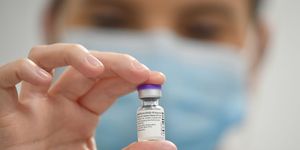- On Tuesday, government officials announced that they would be “pausing” the use of the Johnson & Johnson COVID-19 vaccine.
- There were six reported cases of a rare and severe type of blood clot out of the 6.8 million doses of the Johnson & Johnson vaccine that have been given so far. All of the cases of cerebral venous sinus thrombosis (CVST) involved women between the ages of 18 and 48.
- The risk of this happening to anyone who gets the vaccine is about one in a million, based on the data that’s available so far.
Many people were floored Tuesday morning when government officials announced that they would be “pausing” the use of the Johnson & Johnson COVID-19 vaccine in the U.S. over cases of a rare but serious type of blood clot linked to the vaccine.
The Centers for Disease Control and Prevention (CDC) and Food and Drug Administration (FDA) said in a joint statement that there were six reported cases of a rare and severe type of blood clot out of the 6.8 million doses of the Johnson & Johnson vaccine that have been given so far.
All of the cases of cerebral venous sinus thrombosis (CVST) involved women between the ages of 18 and 48. Each had symptoms appearing six to 13 days after they were vaccinated.
It’s important to note that the risk of this happening to anyone who gets the vaccine is extremely low: It’s about one in a million, based on the data that’s available so far. And plenty of infographics are circulating on social media to hammer that point home.
Many have pointed out that your risk of getting a blood clot from a COVID-19 vaccine is far less than it is if you smoke, take hormonal birth control, or actually have COVID-19.
https://www.instagram.com/p/CNoX2LHB3Ju/
A post shared by Dr. Sarah Pachtman Shetty, MD (@highrisk_pregnancy)
Others point out that the risk of getting a blood clot for the general population is 0.1%—more than the risk if you get the Johnson & Johnson vaccine.
https://www.instagram.com/p/CNnVC8_D1cG/
A post shared by The Unbiased Science Podcast (@unbiasedscipod)
What is CVST, exactly?
Cerebral venous sinus thrombosis (CVST) happens when a blood clot forms in the brain’s venous sinuses, according to Johns Hopkins Medicine. The clot then keeps blood from draining out of the brain, and blood cells can break and leak blood into the brain tissues.
That can lead to a stroke, which can damage the brain and central nervous system. It can also be fatal. According to reports, one woman who received the Johnson & Johnson vaccine died from CVST, while another remains hospitalized.
CVST is rare, and impacts about five people in 1 million each year.
I already got the Johnson & Johnson vaccine. Do I need to do anything?
First, don’t panic. Your risk of getting CVST is “extremely rare,” the CDC and FDA said in their joint statement. Out of an “abundance of caution,” the F.D.A. is advising doctors to pause the Johnson & Johnson vaccine while it investigates extremely rare blood clots.
However, the agencies recommend being on the lookout for symptoms like a severe headache, abdominal pain, leg pain, or shortness of breath within three weeks after you’ve been vaccinated. If that happens to you, call your doctor or go to the ER.
Source: Read Full Article


